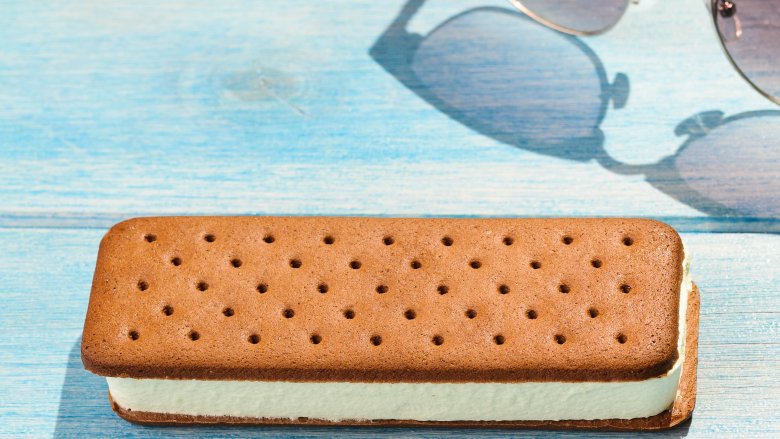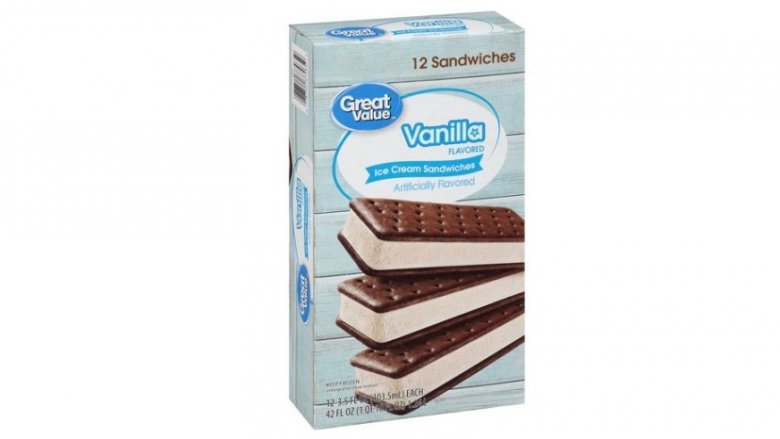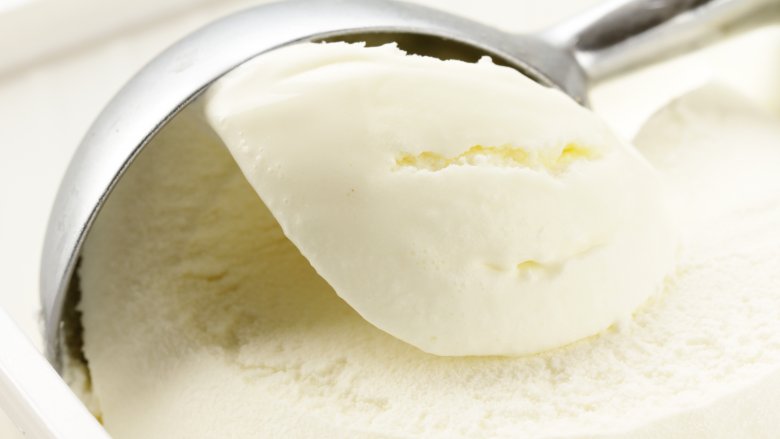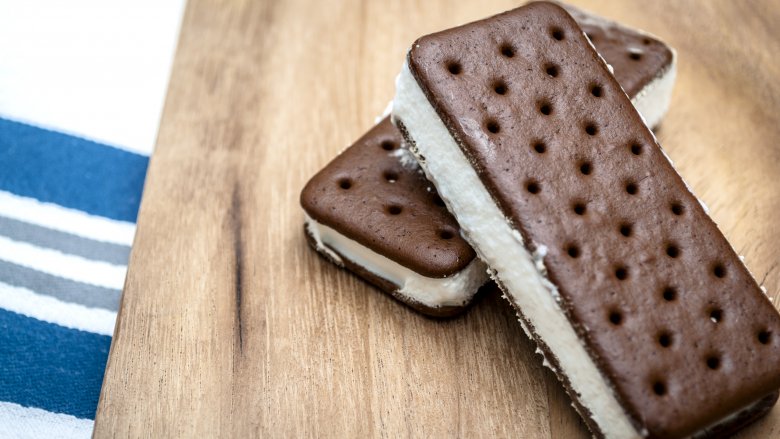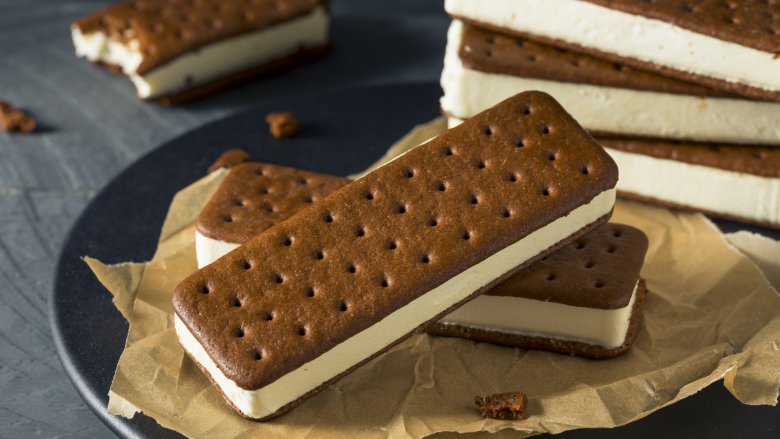The Real Reason Walmart Ice Cream Sandwiches Don't Melt
We may receive a commission on purchases made from links.
It sounds like something that's a complete urban legend, but Snopes says it's at least partly true that Walmart's Great Value Ice Cream Sandwiches don't melt in the sun. The claim started in 2014, and the video proof you may have seen circulating is legit. It's actually pretty neat stuff, so let's look at just why Walmart's ice cream sandwiches don't melt in the sun — not as fast as your ice cream cone, at least — and why that's not such a big deal after all.
So, what's actually in these things?
The first logical question is, "What's in this ice cream that's making it seemingly heat-proof?" Fortunately, Walmart has a list of the ingredients in their Great Value Vanilla Flavored Ice Cream Sandwiches, which are the brand mentioned in the original viral claims. It's a long enough list, but the first is the most important to our purposes. In their ice cream, they say, is milk, cream, buttermilk, sugar, whey, corn syrup, one percent or less of mono- and diglycerides, vanilla extract, guar gum, calcium sulfate, carob bean gum, cellulose gum, carrageenan, artificial flavor, and annatto for color. Sure, there are some artificial-sounding things in there, but they're all names you recognize. Nothing too bad or unexpected, right?
The difference between ice creams
Clearly, there's something that must make the ice cream in these ice cream sandwiches different than the ice cream you get on your favorite cone, and there is. There actually has to be, because if you tried to make an ice cream sandwich out of your favorite Ben & Jerry's flavor, it wouldn't work. It would ooze everywhere as soon as you tried to bite into it, so in order to get the sandwich version to hold its shape the ice cream has to be thicker.
According to Geek.com, that's where some of those additives come in. Both guar gum and calcium sulfate are crucial to the creation, and while guar gum acts as an emulsifier to stabilize the whole thawing process, calcium sulfate absorbs moisture and helps it retain its shape. All those other "gum" ingredients are also thickening agents, but those two are the biggest contributors to what makes this ice cream different from other kinds. That's not all, though.
Why fat content matters
There's yet another factor playing a part in the ability of these ice cream sandwiches to seemingly go against the laws of nature, and that's fat content. According to Virginia Tech professor and food chemist Sean O'Keefe (via the Pittsburgh Post-Gazette), it's not just temperature that determines how fast ice cream melts, it's fat, too. An ice cream that's made with less fat is actually going to melt slower, because it needs to absorb more heat before the melting reaction can take place. It's food science!
There's chemistry going on in your ice cream
All this talk of stabilizers and fat content sounds like one of the least healthy things you've ever eaten, but all ice cream depends on a bit of chemistry to work. Since it's made from sugar and fat, other additives are needed to keep those ingredients from separating. In your standard gallon of ice cream, the American Chemical Society says lecithin is a common emulsifier, used to turn ice cream from a soupy mess into scoopable deliciousness. And if you want some extra stability to your ice cream, they also talk about some other ingredients that should sound familiar by now: guar gum and carrageenan, the stuff that's in our strange ice cream sandwiches. They're pretty common! All those ingredients are acting together to actually change the freezing point of ice cream, and different amounts of ingredients ultimately mean that ice cream isn't going to behave quite like you were taught to expect in science class.
What is guar gum?
Of all the chemical ingredients listed in the ice cream sandwich, guar gum is the one that might have given you some pause. That's probably because in the 1980s, guar gum was used in the manufacture of diet pills, an idea that went terribly sideways. LiveScience says the pills were banned by the FDA because too much guar gum could have some nasty side effects, like swelling of the esophagus.
But, don't fret! They also say in small amounts, guar gum is safe and it's even been found to have some serious benefits. Guar gum — which is made from guar beans like the ones pictured — has been found to help ease symptoms for those suffering from irritable bowel and Crohn's disease, as it gels in the intestine to help keep things moving along. It's also been shown to help lower bad cholesterol, and if you ask us, that's a legitimate reason to add ice cream sandwiches to your diet plan!
It's not just Walmart ice cream sandwiches that don't melt
Just in case you're still leery about Walmart's ice cream sandwiches, you should know they're not the only ones that use stabilizers to help keep their ice cream thick, creamy, and weirdly melt-proof. WCPO Cincinnati did a melt test to compare ice creams, and the test confirmed what we now know. While a cup of Haagen Dazs ice cream melted pretty quickly, a Klondike Bar — which contained some of the same stabilizers as Walmart's ice cream sandwiches — also melted more slowly than expected.
In 2017, we found out slow-melting ice cream sandwiches are actually a global phenomenon when one Australian grandmother posted about her grandson's non-melting ice cream sandwich. The Coles brand sandwich stood up to the heat of the Australian sun (via News.com.au), and while she was quick to jump to the conclusion there was something mysterious about her ice cream sandwich, Coles confirmed it was simply the same bit of food magic found in Walmart ice cream sandwiches — half the world away.
Should you worry?
This is what you really want to know: should you worry? Absolutely not, says Geek.com. There are no suspicious ingredients or dodgy surprises hiding in your favorite ice cream sandwich, and there's no reason to avoid buying them. It's just a matter of some basic food science and a bit of chemistry, and once you know how it works, it's not weird at all! That's fortunate, because ice cream sandwiches are delicious.
